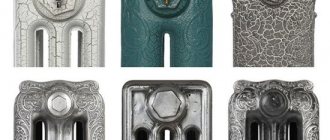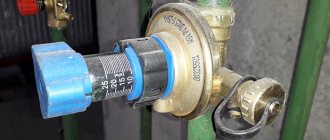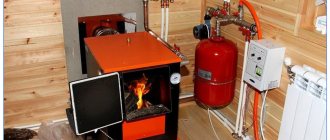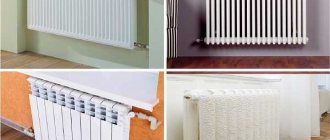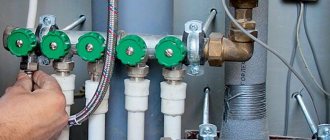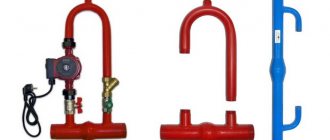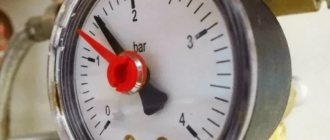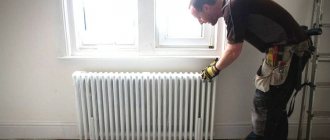Calculating the volume of water (coolant) filling the heating system will be one of the first things when choosing a boiler.
This is necessary to understand what optimal volume your boiler or other heat source can heat. The parameters of the pipes greatly influence this indicator: if you have a pump, you can safely choose a pipe of a smaller diameter and install more heating sections.
If you choose pipes of large diameter, then at maximum boiler power you can get underheating of the coolant: a large volume of water will cool down sooner before reaching the extreme points of the heating system. Which in turn will lead to additional financial costs.
An approximate calculation of the volume of water in the heating system is made from the ratio of 15 liters of water per 1 kW of boiler power.
To determine how much water is needed for a home heating system, consider a simple example.
The boiler power is 4 kW, then the system volume is 4 kW * 15 liters = 60 liters. But it is necessary to take into account the size and number of radiator sections.
If you have a house with 4 rooms, this does not mean that you need to put 12-15 sections in each: it will be very hot and the boiler will not work efficiently. If there are more rooms, then you shouldn’t save on radiators: 1 modern section effectively gives off heat for 2...2.5 m2 of area.
How can you simply determine what power a boiler needs for your home heating system?
Formulas for calculating the volume of liquid (water or other coolant) in the heating system
The volume of water in the heating system can be calculated as the sum of the components:
V = V (radiators)+ V (pipes)+ V (boiler)
The volume of the system must take into account the volume of water in the pipes, boiler and radiators. The calculation of coolant volume does not include the volume of the expansion tank. The volume of the tank is taken into account when calculating critical states of system operation (when water will flow into it when heated).
Formula for calculating the volume of liquid in a pipe:
V (volume) = S (pipe cross-sectional area) * L (pipe length)
Important! Dimensions may vary among different manufacturers, depending on the type of pipe, material, and its production technology. Therefore, it is more convenient to calculate using the actual internal diameter of the pipe, which is easier to measure using a tool. As a rule, such a calculation needs to be performed by a specialist when the heating system is branched and very extended.
Comparison of types of water heating at home (with natural and forced circulation).
Coolant volume in radiators and heating pipes
There are a huge number of different heating radiators on the modern construction market. All of them differ from each other in the material of manufacture and overall dimensions. Accordingly, each section of such devices will hold an unequal amount of water. Let's take a look at the capacity of sections of various radiators:
- aluminum with dimensions 60*8 centimeters - 0.45 liters of liquid;
- bimetallic, with overall dimensions 60*8 centimeters - 0.25 liters
- old cast iron batteries measuring 60*11 centimeters hold 1.7 liters of water;
- modern cast iron heating radiators with dimensions 58 * 7.5 centimeters - 1 liter of liquid.
The differences in the height and width of heating devices from modern manufacturers are within 2 centimeters, while the height of the batteries ranges from 20 centimeters to 1 meter. The volume of other heating devices is calculated based on the proportion. To do this, divide the volume indicated in the table by the height, and then multiply by the height of the required radiator model. If there is a complex, continuous heating system, the volume of liquid in each radiator is checked with the manufacturer.
The volume of pipelines also differs; for calculation it is necessary to take into account the internal diameter. These data were calculated long ago; each meter of pipe has the following values:
- diameter 15 millimeters or 0.5 inches - 0.170 liters;
- diameter 20 millimeters or 0.75 inches - 0.3 liters;
- diameter 25 millimeters or 1 inch - 0.49 liters;
- diameter 32 millimeters or 1.25 inches - 0.8 liters;
- diameter 40 millimeters or 1.5 inches - 1.25 liters;
- diameter 50 millimeters or 2 inches 1.95 liters.
Anyone can calculate the volume of water in a simple heating system. To do this, you need to know the capacity of the boiler and heating radiators. The amount of liquid in pipelines is calculated based on their diameter and length. After this, all values are summed up.
Water volumes for various heating system elements
Water volume (liters) in the radiator section
| Radiator material/type | Dimensions*: height×width, mm | Volume, l |
| Aluminum | 600×80 | 0,450 |
| Bimetal | 600×80 | 0,250 |
| Modern cast iron battery (flat) | 580×75 | 1,000 |
| Old style cast iron battery () | 600×110 | 1,700 |
*IMPORTANT! The dimensions in the table are approximate.
In most models of modern manufacturers, they are ±20 mm in width; the height of heating radiators can vary from 200 to 1000 mm.
The volume of radiators with very different heights can be approximately calculated from this table using the rule of proportion: it is necessary to divide the volume by the height and then multiply by the height of the selected model. If the heating system is extended, then it is better to check the volume parameters with the manufacturer.
Volume of water in 1 linear meter of pipe
- ø15 (G ½") - 0.177 liters
- ø20 (G ¾") - 0.310 liters
- ø25 (G 1.0″) – 0.490 liters
- ø32 (G 1¼") - 0.800 liters
- ø40 (G 1½") - 1,250 liters
- ø50 (G 2.0″) – 1,960 liters
Also read the review of which pipes are best to choose.
The main dimensions of the internal diameters of pipes (a range of values from 14 to 54 mm are taken) that the consumer may encounter.
| Inner diameter, mm | Volume of liquid in 1 m of pipe running, l | Inner diameter, mm | Volume of liquid in 1 m of pipe running, l |
| 14 | 0,1539 | 30 | 0,7069 |
| 15 | 0,1767 | 32 | 0,8042 |
| 16 | 0,2011 | 34 | 0,9079 |
| 17 | 0,2270 | 36 | 1,0179 |
| 18 | 0,2545 | 38 | 1,1341 |
| 19 | 0,2835 | 40 | 1,2566 |
| 20 | 0,3142 | 42 | 1,3854 |
| 21 | 0,3464 | 44 | 1,5205 |
| 22 | 0,3801 | 46 | 1,6619 |
| 23 | 0,4155 | 48 | 1,8096 |
| 24 | 0,4524 | 50 | 1,9635 |
| 26 | 0,5309 | 52 | 2,1237 |
| 28 | 0,6158 | 54 | 2,2902 |
Water for domestic needs - calculation of the power of the domestic hot water circuit
In gas double-circuit boilers, water for domestic hot water is heated using a flow-through method. The time of water flow through the heat exchanger is insignificant, so the power of the unit must be such as to have time to heat it.
The minimum power of such a unit should be at least 18 kW. To reduce it, a storage tank is used, in which the heated water maintains its temperature for some time and allows you to use hot water immediately after opening the tap.
Example of a DHW circuit
When using a single-circuit boiler together with a boiler to produce hot water, the boiler capacity should be 80 liters to allow comfortable use and reduce fuel consumption by the boiler.
Expansion tank calculation
Basic Rules:
- The volume of the expansion tank must be at least 10% of the volume of the heating system. This volume will be sufficient to expand the coolant when heated within 45...80 °C.
- For large extended systems with high coolant temperatures, the volume reserve should be at least 80% of the volume of the heating system. This is relevant for boilers with a maximum coolant temperature above 80...90 °C, and steam heating systems from furnaces.
- The volume of the expansion tank with a safety valve can be 3-5% of the volume of the heating system. But at the same time, it is important to control its operation: when the valve operates, it is necessary to replenish the system with water.
- When calculating, it is necessary to take into account the pressure in the system. In most cases, for one and two-story cottages it is 1.5...2 atmospheres. The weight of the finished tanks is calculated for these indicators with a margin. When designing a large-volume heating system with increased pressure characteristics in communications (for high-rise buildings), it is necessary to take this parameter into account.
- It is imperative to take into account the type of coolant when choosing. The lighter the fluid in the system, the larger the expansion tank it requires.
Comparison : Which boiler to choose for heating your home? Advantages and disadvantages.
Water is the most common coolant
Water and antifreeze are used as coolant in boilers.
Water is used much more often for the following reasons:
- water is the cheapest coolant;
- has a high heat capacity - the ability to give off heat. Water heated to 90 degrees and cooled to 70 degrees in heating radiators gives off 20 kcal of heat to the surrounding air per 1 kg of its own weight;
- environmentally friendly, safe for human health and the environment in case of leaks;
- The volume can be easily replenished in case of leaks - simply add to the expansion tank.
- The leak can be easily eliminated by sealing the leak site.
At the same time, there are disadvantages caused by the content of salts and oxygen in the water, which contribute to the formation of scale on the walls of the internal parts of the boiler. Scale reduces the flow of water through the coolant and heat transfer.
Therefore, it is best to use distilled or rain water. Before filling, you should thoroughly rinse the entire heating system, regardless of whether it is old or new.
Types of coolants
- Water . The simplest and most accessible resource. Can be used in any heating systems. In combination with polypropylene pipes - an almost eternal coolant.
- Antifreeze . Used to fill systems of irregularly heated buildings.
- Liquids containing alcohol . An expensive option for filling the heating system. High-quality preparations contain at least 60% alcohol, about 30% water, and part of the volume is occupied by other additives. Mixtures of water with ethyl alcohol with different percentages. Non-freezing liquid (down to -30°C with an alcohol content of at least 45%), but dangerous: it can burn, ethyl itself is poisonous for humans.
- Oil . As a coolant today it is used in individual heating devices, but in heating systems it is abandoned: it is expensive and difficult to operate the system, technologically dangerous (long heating of the coolant to a temperature of 120°C and above is required). The advantage is that it really takes a long time to cool down, maintaining the temperature in the room, but the main disadvantage is the high cost of the coolant.
Coolant flow
Coolant flow is calculated using the formula:
where Q is the total power of the heating system, kW; taken from the calculation of heat loss of the building
Cp—specific heat capacity of water, kJ/(kg*deg.C); for simplified calculations we take it equal to 4.19 kJ/(kg*deg.C)
Coolant flow calculator (water only)
In the same way, you can calculate the coolant flow on any section of the pipe. The sections are selected so that the water velocity in the pipe is the same. Thus, the division into sections occurs up to the tee, or before the reduction. It is necessary to sum up the power of all radiators to which the coolant flows through each section of the pipe. Then substitute the value into the formula above. These calculations must be made for the pipes in front of each radiator.
Features of selecting a circulation pump
The pump is selected according to two criteria:
- The amount of pumped liquid, expressed in cubic meters per hour (m³/h).
- Pressure expressed in meters (m).
With pressure, everything is more or less clear - this is the height to which the liquid must be raised and is measured from the lowest to the highest point or to the next pump, if the project provides more than one.
Expansion tank volume
Everyone knows that liquid tends to increase in volume when heated. To prevent the heating system from looking like a bomb and leaking at all the seams, there is an expansion tank into which the displaced water from the system is collected.
What size tank should I purchase or make?
Everything is simple, knowing the physical characteristics of water.
We multiply the calculated volume of coolant in the system by 0.08. For example, for 100 liters of coolant, the expansion tank will have a volume of 8 liters.
Let's talk about the amount of pumped liquid in more detail.
Water consumption in the heating system is calculated using the formula:
G = Q / (c * (t2 - t1)), where:
- G – water consumption in the heating system, kg/sec;
- Q – amount of heat compensating for heat loss, W;
- c is the specific heat capacity of water, this value is known and equal to 4200 J/kg*ᵒC (note that any other coolants have worse performance compared to water);
- t2 – temperature of the coolant entering the system, ᵒС;
- t1 – coolant temperature at the outlet of the system, ᵒС;
Recommendation! For comfortable living, the temperature delta of the coolant at the inlet should be 7-15 degrees. The floor temperature in the “warm floor” system should not be more than 29 ᵒ
C. Therefore, you will have to figure out for yourself what type of heating will be installed in the house: will there be radiators, “warm floor” or a combination of several types.
The result of this formula will give the coolant consumption per second of time to replenish heat loss, then this indicator is converted into hours.
Advice! Most likely, the temperature during operation will vary depending on the circumstances and season, so it is better to immediately add 30% of the reserve to this indicator.
Let's consider the indicator the calculated amount of heat required to compensate for heat losses.
Perhaps this is the most complex and important criterion, requiring engineering knowledge, which must be approached responsibly.
If this is a private house, then the indicator can vary from 10-15 W/m² (such indicators are typical for “passive houses”) to 200 W/m² or more (if it is a thin wall with no or insufficient insulation).
In practice, construction and trade organizations take the heat loss indicator as a basis - 100 W/m².
Recommendation: calculate this indicator for a specific house in which a heating system will be installed or reconstructed. For this, heat loss calculators are used, with losses for walls, roofs, windows, and floors being calculated separately. These data will make it possible to find out how much heat a house physically releases into the environment in a specific region with its own climate regimes.
We multiply the calculated loss figure by the area of the house and then substitute it into the water consumption formula.
Now you need to deal with the issue of water consumption in the heating system of an apartment building.



